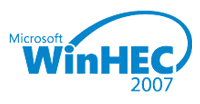Microsoft: Windows Server to Outpace Linux 3:1 by 2010
 LOS ANGELES - A video just shown here during the Day 2 morning keynote session at WinHEC showed Microsoft's "crack" server team working hard on the critical task of naming its new server operating system. After considering such candidates as "Windows Server Server Edition" and "I Can't Believe It's Not Windows NT," the team leader ends up tinkering with the name "Windows Server 2003" on the whiteboard, changing the "3" to an "8."
LOS ANGELES - A video just shown here during the Day 2 morning keynote session at WinHEC showed Microsoft's "crack" server team working hard on the critical task of naming its new server operating system. After considering such candidates as "Windows Server Server Edition" and "I Can't Believe It's Not Windows NT," the team leader ends up tinkering with the name "Windows Server 2003" on the whiteboard, changing the "3" to an "8."
The message of the video was well-taken: Microsoft's taking itself a little less seriously now, coming to grips with its own legendary geekiness.
As the company's new general manager for Windows Server 2008, Bill Laing, took the stage, he started making a little news, shedding light on the company's server roadmap. Citing IDC numbers predicting Windows Server installations overall to outpace the growth of Linux, at 8 million versus 2.75 million by 2010, Laing said his company has established a "predictable rhythm of releases" going back to Windows 2000, and that this rhythm will not change going forward.
Laing's statement puts to rest any speculation that WS2K8 will be Microsoft's last "major release" of the operating system, and that the company would begin adopting a regular pattern of semi-annual server upgrades or service packs. He firmly said the company will continue its pattern of major releases every four to five years, with update releases in the two-to-three year intermediate timeframe.
With Microsoft's kernel development now synchronized between client and server lines, this timeframe pattern will likely apply to "Blackcomb" and future Windows client editions.
He followed up by saying that WS2K8 will be the company's final 32-bit operating system, with all future releases moving to 64-bit.
9:15 am PT - Midway through, Laing and product manager Alex Balcanquall revealed some news regarding the "Anywhere Access" program - the ability for networked or remote users to run Windows applications without their actually being installed on their systems. Laing said the company is leveraging some of its virtualization technology to that end, having invested (probably meaning, purchasing from elsewhere) a concept called SoftGrid. It's not ready to demonstrate yet, but it involves being able to "stream" application content from a server to a remote or networked client and have it run within a virtual machine envelope, dedicated exclusively to that application.
Last year at TechEd, we saw the first demonstrations of Vista's ability to run Windows apps via Terminal Services - a browser-based envelope within which Microsoft Office apps can be run on a remote or lower-order client. At that time, when the floor was opened for questions, a number of people shouted, "Printer drivers??" The presenters at that time looked a little red-faced, as if it was the first time they'd encountered the topic.
This year, Balcanquall showed an updated version of the Terminal Services demo. In that demo, a relatively unequipped Vista-based client ran Visio remotely, logging into the terminal server through a single prompt (a big advance for many of you familiar with Terminal Services). After pulling up a graph (for those of you keeping score at home, Visio ran in the Vista Basic theme, not the full Aero scheme), Balcanquall then proceeded to print the graph using the native local printer driver - not a generic or bypass driver. The demo garnered the most applause of the day thus far.
